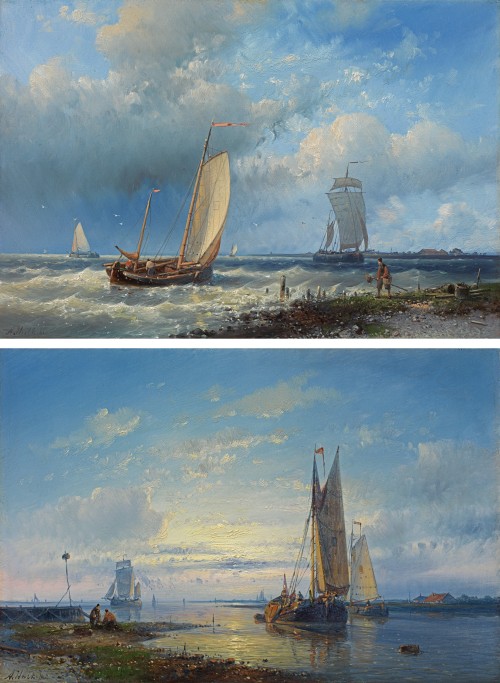JEAN BAPTISTE CAMILLE COROT
Paris 1796 - 1875 Ville d'Avray
Ref: BY 146
Passiance [Landes]
Signed lower left: Corot
Oil on canvas: 20 x 24¼ in / 50.8 x 61.6 cm
Frame Size: 27 x 31 inches / 68.6 x 78.7 cm
Painted in October 1872
Provenance:
M. Disant-Grédelue, acquired from the artist
M. Camentron
Arthur Hennecke Collection, Brandenburg
Max von Bleichert (1875-1947);
his sale, Rudolph Lepke, Berlin, 8th December 1931, lot 3
Galerie Dr Hans-Peter Bühler, Munich;
from whom acquired in 1985 by a private collector, Switzerland
Literature:
Alfred Robaut, L’Oeuvre de Corot, Paris 1905, vol. III, pp.272-3, no.2078, illus.
Martin Dieterle and and Claire Lebeau have confirmed that this is an autograph work by Jean-Baptiste-Camille Corot
‘Beauty in art consists of a truthfulness in the impression we have received from an aspect of nature...the real is one part of art; the sentiment completes it’, Corot declared in 1856. In his mature paintings, he distils the essence of a landscape, wafting over it a haze of poetry that led van Gogh to write of the ‘quietness, mystery and peace’ of his work.
Corot was an indefatigable traveller. In 1872, the year that this painting was made, he made no less than seventeen excursions, searching for new motifs, enjoying the company of friends. According to Alfred Robaut, Passiance (Landes) is related to an oil study, Passiance, près Saint-Avit (Landes)[1]made while Corot was staying with M. de Rivière in the Landes region of south-western France. The present painting is a larger, more detailed meditation on this motif, executed in Corot’s studio at Coubron[2], east of Paris, where Corot often sought tranquillity with the Gratiot family.
Trees, filtering the soft light, dominate the scene. Peasants work in the fields and a traveller waters his horse. There is a poetic sense of timelessness in la France profonde. Corot substituted the road in the right foreground of the oil study with the pond in the present work, opening up an area of radiance that reflects the serpentine band of cloudscape above. Corot’s paintings owe their magic to the perfectly-judged placement of areas of light and dark, the filtering of sunlight through shimmering leaves, the balance of topography and generalization. In creating these landscapes he was paying homage to the work of Claude Lorrain (1600-1682), who presented Italy as an Arcadian dream. Corot threw a similar spell over the landscapes of France and was fêted by connoisseurs and fellow artists alike.
JEAN-BAPTISTE-CAMILLE COROT
Paris 1796 - 1875 Ville d’Avray
Born into a Parisian merchant’s family, Jean-Baptiste-Camille Corot renounced his commercial heritage in order to pursue his vocation as a painter. Despite his family’s opposition, he received an allowance from his father that enabled him to study first with Michallon, and then with Bertin, both neo-classical landscape painters.
In 1825 Corot made his first visit to Italy. During the three years he spent there he painted many of his most spontaneous plein air masterpieces, remarkable for their fidelity to nature, a classical concern with form and the precise observation of tonal values. In 1834 and 1843, he made two more visits to Italy, painting in Rome, Florence and Venice.
Corot also painted more academic and finished works which he considered more suitable for the Paris Salon, where he exhibited from 1827. He received a second-class medal at the Salon in 1833 and was awarded the Légion d’Honneur in 1846. During the 1830s, Corot was influenced by Dutch seventeenth century artists, especially Jacob van Ruisdael. Apart from this Dutch phase, however, his paintings tended to convey a more idealised concept of nature, expressed in a Claudian vein, which often included literary, allegorical or mythological subjects.
Corot travelled extensively throughout France, painting along the Channel coast and in Fontainebleau. His most cherished spot was at Ville d’Avray near Versailles, where his parents had purchased a villa amidst a landscape that was of particular aesthetic appeal. He visited Holland in 1854 and England in 1862.
Corot’s increasingly idealised concept of landscape resulted in the all-pervasive lyricism that characterised his late work. He entitled these paintings souvenirs, which were essentially nostalgic distillations of his visual experience, admired for their delicate, dreamlike quality. In 1856 Corot wrote: ‘Beauty in art consists of a truthfulness in the impression we have received from an aspect of nature... the real is one part of art; the sentiment completes it’. It was the diaphanous, twilight effects of his paintings that epitomized such sentiment and greatly appealed to the prevalent neo-Rococo taste.
From the late 1840s, Corot became acquainted with the Barbizon painters, particularly Daubigny, Millet and Rousseau, with whom he painted and studied the new art of photography. His interest in naturalism and an unerring fidelity to his own personal vision earned him the esteem of many younger artists, including Harpignies, Lépine and Pissarro; it was they who named him with reverence Père Corot.
[1] 10 ½ x 13 ¼ in / 27 x 34 cm; formerly Robaut Collection. Robaut, vol. III, op. cit., p.272, no.2077, illus.
[2] See Robaut, ibid., vol. III, p.272, no.2078.

![Jean-Baptiste-Camille Corot - Passiance [Landes]](/oimgnn/images_products/HD_478_bc1b82858b896871d7fde32923b8bdf8-500.jpg)
![Jean-Baptiste-Camille Corot - Passiance [Landes] Jean-Baptiste-Camille Corot - Passiance [Landes]](/images_products/L_478_bc1b82858b896871d7fde32923b8bdf8.jpg)
![Jean-Baptiste-Camille Corot - Passiance [Landes] Jean-Baptiste-Camille Corot - Passiance [Landes]](/images_products/L_BY146F.png)


![Jean-Baptiste-Camille Corot - Passiance [Landes] Jean-Baptiste-Camille Corot - Passiance [Landes]](/images_products/T_478_bc1b82858b896871d7fde32923b8bdf8.jpg)














